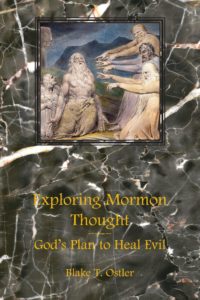 Title: Exploring Mormon Thought: Volume 4, God’s Plan to Heal Evil
Title: Exploring Mormon Thought: Volume 4, God’s Plan to Heal Evil
Author: Blake T. Ostler
Publisher: Greg Kofford Books
Genre: Theology
Year Published: 2020
Number of Pages: 255
Binding: Hardback; Paperback
Price: Hardback, 34.95; Paperback, 24.95
Reviewed by Erik Champenois
Ostler’s fourth volume of Exploring Mormon Thought delves deeply into the problem of evil and how Mormon Christianity presents unique solutions to the problem of evil. This volume is more concise and focused than some of the other books in the series, at about 225 pages, and is easier to follow, at least if you have read some of the other volumes first. I highly recommend reading at least volume 1 before this book as some of the basic concepts and theories referenced in this book are more fully presented there.
Ostler starts by focusing his discussion of evil on those radical evils that destroy the humanity of their victims. He reviews the basic argument against the existence of God based on there being evil in the world. Drawing on arguments consistent with logic presented in prior volumes, he concludes that indeed the “omni-God” of classical theism/traditional Christianity cannot exist given the existence of evil in the world. Instead, Ostler presents three systematic theodicies inspired by LDS theology – a Mormon finitistic theodicy, a Mormon process theodicy, and his own “relational agape” theodicy. He concludes by reviewing his compassion theory of Christ’s atonement (previously presented in his second volume) and responding to critiques of that theory.
I won’t go into details on the different theodicies in this review, but I will note that the three alternatives presented are not necessarily completely mutually exclusive in that one could present a theodicy that combines elements of each. I also want to note that a finitistic theodicy could be developed that presents a relatively less limited God than the one Ostler argues against. Indeed, it seems to me that the finitistic and relational agape theories could meet somewhere in the middle. While Ostler argues against classical theism, it seems to me that his conception of God leans up closer to classical theism than needs to be the case – as Ostler is dedicated to a conception of God as maximally powerful and knowledgeable as philosophically possible given LDS commitments (no ex nihilo creation and allowing for free will). I personally lean more in favor of a finitistic conception of God as being more compatible with the theology of Joseph Smith and other early church leaders.
Another way to tackle theodicy is to explain not just how the existence of evil can be consistent with the existence of God but how the existence of evil can be consistent with the existence of a God of miracles. To the extent that a theodicy results in limits on when/where God can/will intervene to overcome evil, to that extent the theodicy also makes the concept of a God of miracles more difficult – or at least makes God’s miracles and interventions more limited and rare. A strength of the relational agape theodicy is that this theodicy is more consistent with God being able to intervene, whereas the finitist and process theodicies put more limits on God’s ability to intervene. Though again I would argue that one could meet in the middle by combining elements of each.
Ostler explains God’s frequent non-intervention as based on a mixture of the necessity of a universe with full freedom to choose between good and evil, interventions being the result of faith as a co-creation between God and man rather than of God alone, and the theology of pre-existent/premortal consent to a world of evil (and possibly to specific evils). In the end, the existence of evil, even of radical evil, is a necessary part of allowing for the ability to grow closer to God through learning from our experiences and overcoming evil. And full meaning is not found in just the experience with evil, but in God’s plan to heal all evil through the atonement.
As I read through this book and Ostler’s other volumes I have thought about the value of the pursuit of theology. We know from religious history that elaborately constructed systems of theology have been created that in the end were based on historically contingent religious teachings as well as on now dated and invalid scientific theories of the world. Indeed, Judaic, Christian, and even Mormon religious teachings and doctrines have evolved and changed over time, and correspondingly given rise to different philosophical theories and theologies over time. A critical and historical perspective of theology seems to me to call for a certain amount of skepticism about the endeavor of theology itself, or at least for a humility that recognizes that our analytical speculations are limited by our powers of analysis. There is value in an openness to unknowingness and to recognizing that “we see through a glass, darkly” (1 Corinthians 13:12).
And yet I do find value and inspiration in the endeavor of theology. Certainly thinking deeply through the things of God should be considered at least a partial fulfillment of the biblical command to love God with all of one’s mind. And even if one doesn’t reach absolute certainty on a number of topics, thoughtful analytical thinking can at least lead to some consideration of what is logically possible or impossible and what theological conclusions seem more or less likely given certain assumptions and commitments to truth claims. It is in that regard that I find Ostler’s series on Exploring Mormon Thought a must read for any serious student of the theology of Mormonism.
